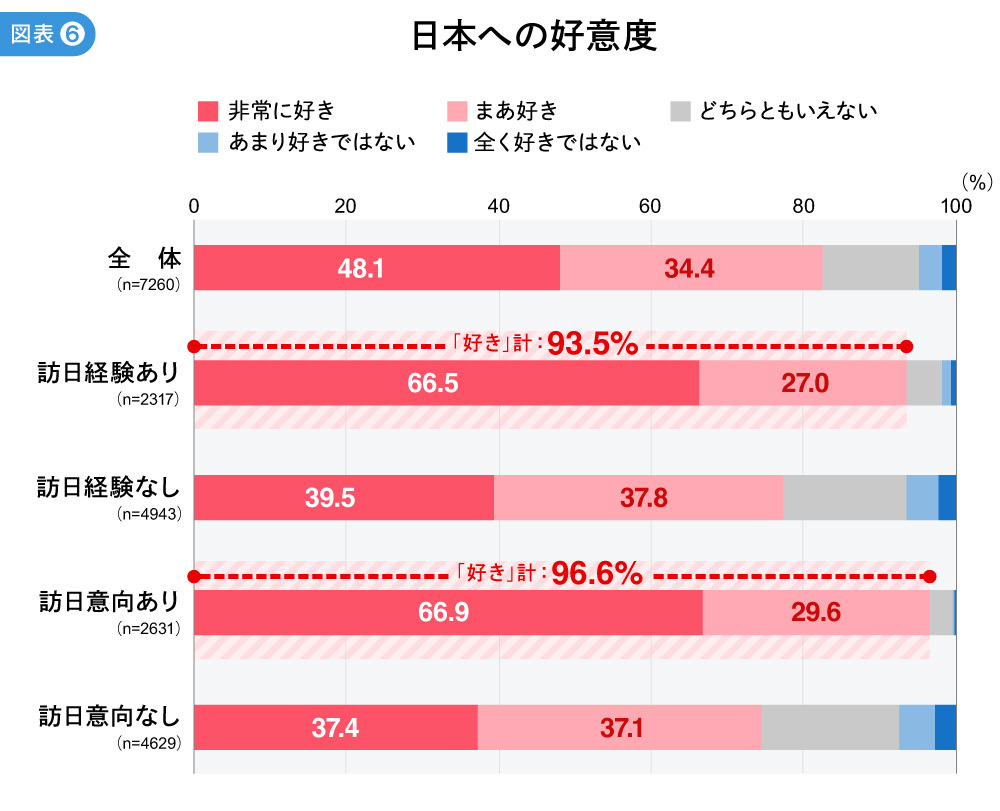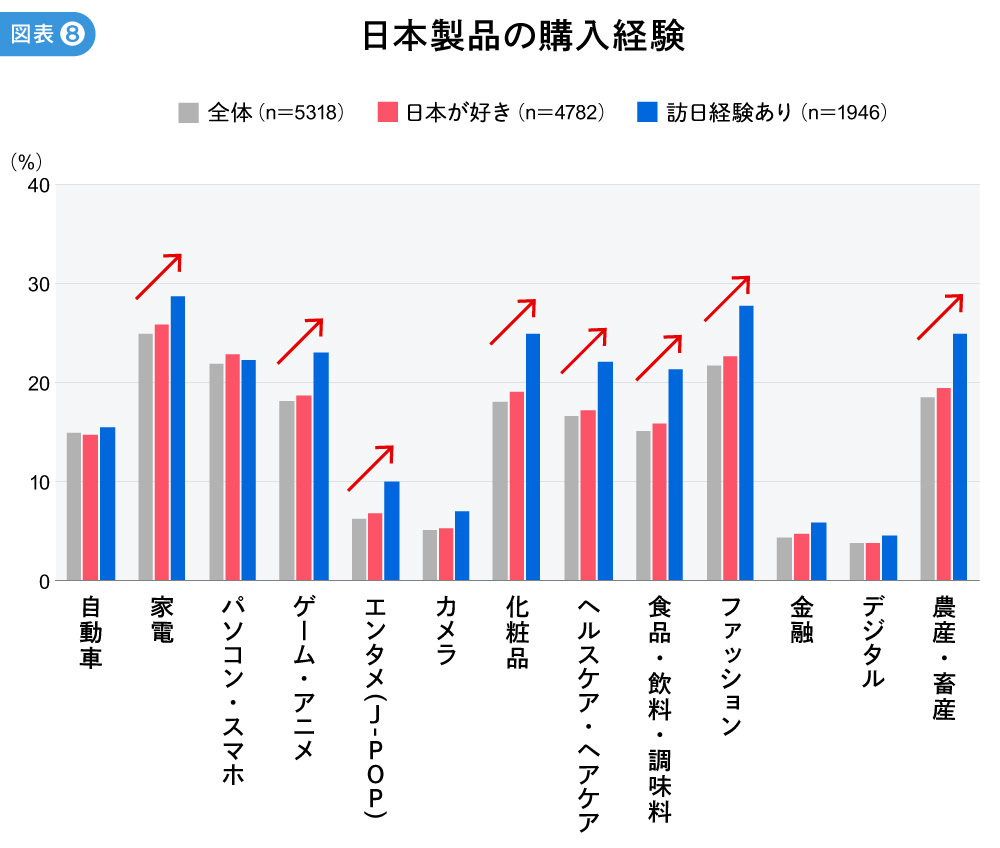Over a year has passed since October 2022, when border measures against COVID-19 were significantly relaxed. The Japan National Tourism Organization (JNTO) announced on November 15th that October's inbound visitor numbers reached 2,516,500, representing 100.8% of the same month in 2019. This marks the first time since the COVID-19 outbreak that the number exceeded the same month in 2019, indicating that Japan's inbound tourism has recovered to pre-pandemic levels.
While the weak yen has certainly played a role, the strong performance appears driven primarily by increased visitor numbers from Southeast Asia (particularly Singapore), as well as Europe, the US, Germany, and Australia. Will this momentum continue? What kind of people will visit Japan going forward? Based on the findings of the "Dentsu Inc. Japan Brand Survey" (details here), we explore the future of Japan's inbound tourism.
Japan is the No. 1 destination people want to visit next, but there are differences by country/region. The key to sustained growth lies with repeat visitors.
When asked which countries/regions they are specifically considering for their next overseas trip, Japan ranked No. 1, far ahead of the second-place United States. Notably, scores were particularly high among those with prior visit experience (Chart ①).

Conversely, examining Japan's ranking by country/region reveals it ranks 4th in the US and fails to crack the top 5 in several European countries (Chart 2). This indicates that while Japan is recognized as a "destination people want to visit in the future" (2022 survey), it is not yet widely considered as a specific "next destination" for travel.
For Japan's inbound tourism to continue growing, the challenge lies in prompting concrete action from those who vaguely "want to go," especially encouraging those who have already visited Japan—who seem more likely to take action—to revisit and cultivate them as repeat visitors.
As the impact of COVID-19 fades, "experiences only possible in Japan" are gaining popularity. The areas repeat visitors are targeting next are "Hokkaido" and "Kyushu."
When asked again this year about "things they want to do in Japan," changes appeared in the top items. In the previous results, nature-related experiences—which gained significant interest during the pandemic—dominated the top rankings and scored far higher than others.
In this survey, while nature-related experiences remain in the top 10, their scores and rankings have fallen. Instead, theme parks have risen in rank, and experiences like "staying at a traditional Japanese inn" and food-related activities have newly entered the top 10 (Chart 3).

Looking at the results for those with prior visit experience using the same question, the top items remain unchanged. However, compared to the overall results, "nature"-related experiences appear among the items with higher scores, while "food" and "hot spring"-related experiences stand out (Chart ④).
Food and hot springs were perennial top-ranked activities in pre-pandemic Japan travel. These results suggest that major demand for Japan travel has returned to pre-pandemic levels, while "unique Japanese experiences" perceived as appealing—such as theme parks and izakaya—are diversifying further. As overseas travel becomes commonplace again and the impact of COVID-19 fades, it seems we can interpret this as a growing tendency to seek "experiences only possible in that specific place," regardless of whether they are nature-related or not.
So, where specifically in Japan are visitors heading? The top "prefectures they want to visit" remain unchanged: "Tokyo," "Hokkaido," "Osaka," "Kyoto," and "Okinawa." However, looking at the intentions of those with prior visit experience, scores are particularly high for "Hokkaido" and the "Kyushu region."
Looking at the details, scores are high not only in popular areas like Hokkaido, Okinawa, and Kyoto, but also in "areas they haven't visited before" like Tohoku and Kyushu, "places with theme parks" like Osaka and Nagasaki, and "places accessible from major cities" like Kanagawa, Chiba, Saitama, and Nara (Figure 5).

From staple cities like "Tokyo," "Osaka," and "Kyoto" to nature-rich areas like "Hokkaido" and "Okinawa." Furthermore, repeat visitors delve deeper into the aspects of Japan that interest them personally, venturing into areas less frequently visited by tourists. By nurturing repeat visitors, we can expect a broader spread of people to diverse regions.
Was Japan's soft power behind the inbound recovery? Fans of Japan, entering through diverse gateways, experience the Japan they love
What kind of people are these "past visitors" or "intended visitors" who are repeaters or have the potential to become repeaters? Looking at the impressions of Japan held by "past visitors" and "intended visitors," it becomes clear that many have a high level of favorability toward Japan (Chart ⑥).
In a 2019 article, we noted that "people who like Japan are often those who have visited Japan," and this survey confirms the same trend. While positive sentiment toward Japan tends to be particularly high in Southeast Asian countries and regions, compared to pre-COVID levels, it has also increased in non-Asian countries like the United States, the United Kingdom, and Australia (compared to the 2019 survey, the combined score for "very fond" and "somewhat fond" increased by +5.1 points in the U.S., +9.5 points in Australia, and the "very fond" score increased by +7.8 points in the UK).
Earlier, we mentioned the increase in travelers from Southeast Asia and North America. This rising favorability is likely one factor driving the surge in visitor numbers to Japan, which are approaching pre-pandemic levels.
Moreover, people who like Japan not only have a higher frequency of dining on Japanese cuisine (Chart 7) but also a higher rate of purchasing Japanese products (Chart 8). This tendency is even more pronounced among those who have visited Japan.

As seen in the earlier results regarding "things people want to do in Japan," "food" and "shopping" rank highly. People develop an affinity for Japan through various entry points like food, products, and content. They then visit Japan to experience their favorite things firsthand and purchase items they love. This suggests that Japan's soft power—its culture and values—is serving as the catalyst for visits and driving the recovery of inbound tourism.
Furthermore, visitors to Japan discover new attractions and pursue different pleasures. This virtuous cycle likely fosters repeat visitors and expands business opportunities related to Japan.
Future inbound promotion planning should incorporate perspectives beyond travel needs. For instance, considering the distribution status of Japanese products and the penetration of Japanese culture and cuisine in target countries could lead to initiatives that drive more actionable engagement.
*Country and region names in this article are written for a Japanese domestic audience, following Japanese social norms and business practices.
【Contact for Inquiries Regarding This Matter】
Dentsu Inc. Japan Brand Research Project Secretariat
japanbrand@dentsu.co.jp
【About the Dentsu Inc. Japan Brand Survey】
2011年、東日本大震災により日本の農水産物や訪日旅行に風評被害が発生した際に、Dentsu Inc.が独自に実施した調査。
【Dentsu Inc. Japan Brand Survey 2023 Overview】
・Target Areas: 19 countries/regions (United States, China, South Korea, Taiwan, Hong Kong, Singapore, Thailand, Malaysia, Indonesia, Vietnam, Philippines, India, Australia, Saudi Arabia, United Kingdom, France, Germany, Italy, Spain)
・Respondent Criteria: Middle-to-high income individuals, men and women aged 20s to 50s
・Sample Size: 7,260 respondents (USA=960, China=1,200, Other countries/regions=300 each). Samples collected with equal allocation by gender and age group in each country/region, then weighted to match population proportions.
・Survey Method: Online survey
・Survey Period: December 2022 - January 2023
・Research Institution: Video Research Ltd.












